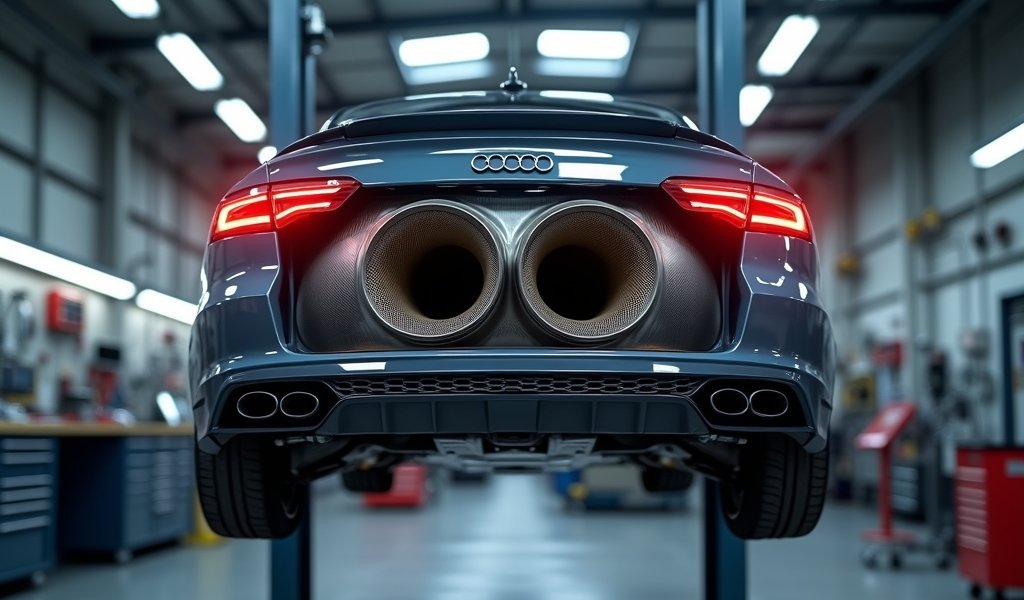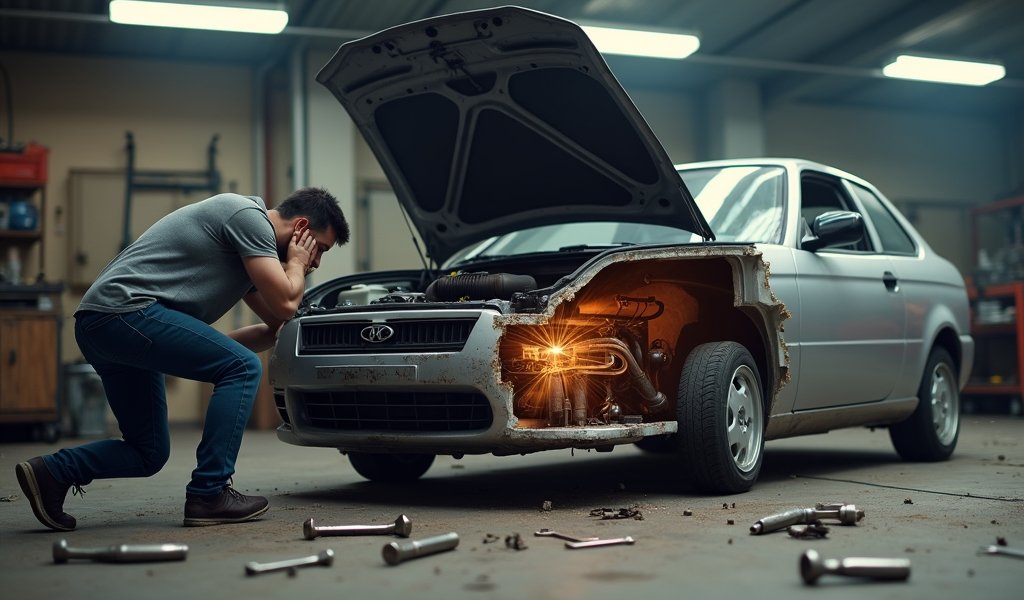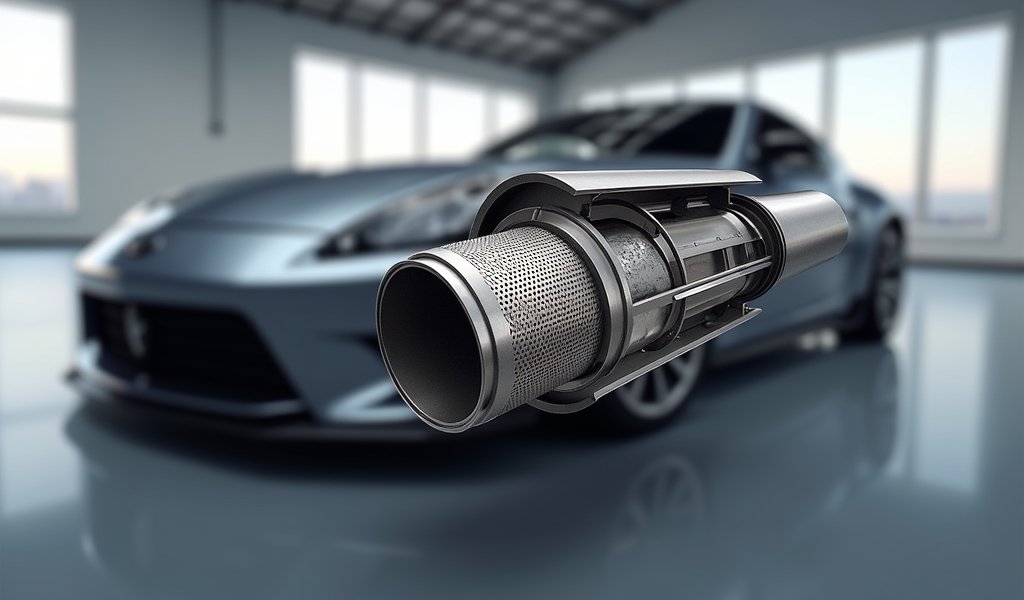Overview
Muffler internal baffles use various designs (straight-through, chambered, turbo, and resonator-style) to reduce exhaust noise through sound absorption and wave cancellation while balancing performance needs. The article covers baffle materials (stainless steel being premium), their impact on engine performance, DIY construction techniques, troubleshooting common failures, and emphasizes the importance of quality components for longevity and optimal sound control.
Table of Contents
- Understanding Muffler Basics
- How Baffles Work: The Science of Silence
- Types of Baffle Designs
- Baffle Materials: What Makes a Quality Muffler
- Performance Impact: Balancing Flow and Noise
- DIY Baffle Construction: Tips from the Shop
- Troubleshooting Baffle Issues
- Conclusion
- Frequently Asked Questions
Understanding Muffler Basics
Every time your engine fires, it creates explosive bursts of expanding gases that would sound like gunshots without proper muffling. That’s where the humble muffler earns its keep. At the heart of every muffler lies a carefully designed system of internal baffles – the unsung heroes that transform ear-splitting noise into a civilized purr.
I’ve spent 20 years under hoods and chassis, and I can tell you that understanding muffler internal baffle construction is like peeking behind the wizard’s curtain. These seemingly simple metal chambers perform acoustic magic that makes modern driving bearable.
Mufflers work on two core principles: sound absorption and wave cancellation. When exhaust gases rush through your system, they create pressure waves – essentially sound – that need taming. Internal baffles create paths that force these sound waves to bounce around, collide with each other, and gradually lose energy.
Think of it like this: without baffles, your exhaust would be a straight pipe megaphone amplifying every combustion event. With properly constructed baffles, it becomes an acoustic labyrinth where sound gets lost and diminished before reaching your neighbors’ ears.
How Baffles Work: The Science of Silence

Ever wonder why you can have two identical-looking mufflers that sound completely different? It’s all in the baffle design. These internal structures work through several clever mechanisms to quiet your ride without choking engine performance.
When sound waves travel through a muffler, the baffles create reflection points where the waves bounce back toward incoming waves. When a compression wave meets a rarefaction wave, they partially cancel each other out – like two ocean waves colliding and flattening. This phenomenon, called destructive interference, is your muffler’s primary noise-fighting tool.
Baffles also force exhaust to change direction repeatedly. Each turn creates resistance to flow but also bleeds off acoustic energy. It’s a delicate balance – too many turns and your engine feels strangled; too few and your exhaust sounds like a bullhorn.
The chambers created by baffles also have specific volumes that target certain sound frequencies. This is why performance mufflers can eliminate irritating high-pitched tones while preserving that deep, satisfying rumble that aftermarket exhaust enthusiasts crave.
Modern baffle designs also incorporate expansion chambers where the exhaust path suddenly widens. This causes a pressure drop that dissipates energy and reduces noise. It’s similar to how a river calms when it flows into a wider channel.
Types of Baffle Designs
In my years at the shop, I’ve cut open hundreds of mufflers and found several distinct baffle configurations. Each has its strengths and signature sound profile.
Straight-Through Perforated Designs
These are the simplest and most flow-friendly designs. A perforated tube runs through the muffler with sound-absorbing material packed around it. Sound waves escape through the perforations and get trapped in the packing material, while exhaust flows relatively freely.
This design is popular in performance applications where minimizing back pressure is crucial. They typically produce a louder, more aggressive tone that many sports car enthusiasts prefer. Research from performance exhaust manufacturers shows they can flow up to 30% better than chambered designs.
Chambered Mufflers
These contain multiple chambers connected by tubes or holes. Exhaust gases must navigate this maze, changing direction repeatedly. Each chamber is carefully sized to resonate at specific frequencies, canceling particular sound wavelengths.
Chambered mufflers offer excellent noise reduction with moderate flow restriction. They’re the go-to choice for daily drivers where comfort matters more than maximum horsepower. The classic Flowmaster muffler uses this design to create its distinctive muscle car sound.
Turbo Mufflers
Despite the name, these aren’t just for turbocharged engines. They feature an S-shaped path with multiple perforations and chambers. This design excels at quieting high-frequency sounds while maintaining reasonable flow.
Turbo mufflers typically provide the best noise reduction but with higher flow restriction. They’re common on factory exhaust systems where meeting noise regulations takes priority over performance gains.
Resonator-Style Baffles
These specialized designs target specific problematic frequencies like drone or rasp. By creating a chamber that resonates at the exact frequency of an unwanted sound, they can effectively eliminate it while leaving other tones relatively untouched.
Many premium exhaust systems use a combination of these designs – perhaps a straight-through main muffler with a small resonator to handle specific unwanted frequencies. It’s like having a graphic equalizer for your exhaust note.
Baffle Materials: What Makes a Quality Muffler
The hellish environment inside a muffler would destroy most materials in short order. Temperatures can exceed 1,000°F, corrosive condensation forms during cool-down cycles, and constant vibration tests every weld and seam.
Stainless Steel: The Gold Standard
In premium mufflers, you’ll find 304 or 409 stainless steel baffles. These alloys resist corrosion magnificently and maintain structural integrity through countless heat cycles. I’ve seen quality stainless mufflers last 10+ years in harsh environments where aluminized units failed in two.
The downside? Cost. Stainless steel mufflers typically command a 40-80% premium over comparable aluminized units. For most drivers, they’re worth every penny in longevity alone.
Aluminized Steel: The Practical Choice
Most factory mufflers use aluminized steel – regular steel coated with an aluminum-silicon alloy. This coating provides reasonable corrosion resistance at a much lower price point than stainless.
In moderate climates, aluminized baffles can last 3-7 years before deteriorating. They’re the sensible middle ground for most applications – not as durable as stainless but far more cost-effective for typical use cases.
Sound-Absorbing Materials
The space between baffles often contains materials designed to absorb sound waves. Traditionally, this was fiberglass, which works wonderfully until it breaks down from heat and moisture.
Modern mufflers often use more advanced materials like continuous filament fiber or ceramic wool, which can withstand higher temperatures without degradation. These materials trap sound waves in their fibrous structure, converting acoustic energy to heat through friction.
Some ultra-premium mufflers use stainless steel wool as the absorptive material. It’s virtually indestructible but significantly more expensive than fiber alternatives.
Performance Impact: Balancing Flow and Noise

There’s an eternal tug-of-war between flow and sound dampening in muffler design. More aggressive noise reduction typically means more flow restriction, which can impact performance. Finding the sweet spot depends entirely on your priorities.
Back pressure isn’t entirely evil – a small amount can actually improve low-end torque in some engine designs. But excessive restriction from overly complex baffle systems can rob your engine of power, especially at higher RPMs where exhaust volume increases dramatically.
In my dyno testing experience, the difference between a straight-pipe and a well-designed performance muffler might be just 2-3 horsepower on a typical street car. But jump to a restrictive OEM muffler, and you could see 8-15 horsepower disappear. The difference becomes more pronounced as engine output increases.
For daily drivers, a moderate-flow chambered design usually provides the best balance. You’ll maintain 95%+ of your engine’s potential while keeping the noise at socially acceptable levels. If you’re building a track car or competition vehicle, straight-through designs make more sense.
Remember that exhaust flow is a system-wide concern. The most free-flowing muffler can’t overcome restrictions upstream in your exhaust manifold, catalytic converter, or pipe diameter. Always consider the entire exhaust path when evaluating performance impacts.
DIY Baffle Construction: Tips from the Shop
Got the fabrication itch? Building custom mufflers can be deeply satisfying work. I’ve designed dozens for special applications, and there’s nothing like hearing your creation sing the perfect exhaust note. But it’s not for beginners – you’ll need solid metalworking skills and some specialized tools.
Essential Tools
- MIG or TIG welder (TIG preferred for thinner materials)
- Metal cutting tools (plasma cutter, bandsaw, or good snips)
- Metal brake for bending sheet metal
- Hole saw set or step drill bits
- Heavy-duty leather gloves and eye protection
- Quality respirator rated for welding fumes
Your base material should be at least 18-gauge stainless steel for durability. Thicker is better for exterior shells (16-gauge), while interior baffles can be 18-20 gauge to save weight.
Design Considerations
Start with a clear idea of your goals. Are you building a track-day screamer or a neighborhood-friendly cruiser? Your design approach will differ dramatically based on your priorities.
For maximum flow with reasonable sound dampening, I recommend a straight-through design with a perforated core (1/8″ holes on 3/16″ centers) wrapped in stainless steel wool. Leave at least 1″ clearance between the core and outer shell for packing material.
For better noise reduction, create a multi-chamber design with offset inlet and outlet. Include at least one expansion chamber with 1.5-2 times the diameter of your inlet pipe. Each directional change will reduce sound at the cost of some flow.
Remember that welding thin stainless is challenging – use lower heat settings and work in short bursts to prevent warping. All internal welds must be solid to prevent pieces from breaking loose and rattling.
Never use materials like regular fiberglass insulation that can break down and exit your exhaust. EPA regulations on particulate emissions are strict, and for good reason – you don’t want to breathe that stuff.
Troubleshooting Baffle Issues
Even the best mufflers eventually develop problems. Recognizing the warning signs early can save you from embarrassing noise violations or more serious exhaust system damage.
Identifying Internal Baffle Failure
The most obvious symptom is a sudden change in exhaust note – usually becoming noticeably louder or developing a rattling sound. This happens when internal baffles crack, break loose, or their mounting welds fail.
You might also notice metallic debris at the tailpipe if components have disintegrated inside. In severe cases, you’ll see visible shell distortion where internal parts have shifted and pushed against the outer casing.
Common Causes of Failure
- Age and heat cycles causing metal fatigue
- Internal corrosion from condensation
- Physical damage from road debris or bottoming out
- Improper welding in aftermarket or repaired units
- Engine modifications increasing exhaust gas temperature
The lifespan of internal baffles varies dramatically based on materials, driving conditions, and climate. In salt-belt states, even good aluminized baffles might last just 3-4 years. In drier climates, I’ve seen them go 7+ years without issues.
Repair Options
Let me be straight with you – internal baffle repair is rarely cost-effective. Once the internals have failed, a replacement muffler is usually your best bet. Temporary fixes like muffler cement or bandage wraps might buy you a little time, but they’re Band-Aids on a deeper problem.
If you’re determined to save a specialty or vintage muffler, some shops offer recore services where they gut the old muffler and weld in new baffles. This is custom work that costs nearly as much as a new unit but might be worth it for rare applications.
For rattles caused by loose internal components, sometimes aggressive driving can shift the loose part to a position where it stops rattling. It’s not a fix, just a temporary reprieve until proper replacement.
Conclusion
The humble muffler baffle deserves more respect than it typically receives. These ingenious internal structures perform complex acoustic engineering in a package smaller than a breadbox, all while enduring one of the most hostile environments in your vehicle.
Understanding muffler internal baffle construction gives you the knowledge to make better choices when it’s time for replacement or upgrades. Whether you prioritize whisper-quiet operation, maximum performance, or the perfect custom exhaust note, the right baffle design can help you achieve your goals.
Remember that quality matters tremendously in this component. The few extra dollars for superior materials and construction will pay dividends in longevity and consistent performance. Your ears – and your neighbors – will thank you for investing in proper muffler technology.
Next time you’re under your vehicle or shopping for exhaust components, take a moment to appreciate these silent heroes. The science and engineering behind modern muffler baffles represent decades of refinement aimed at making your driving experience more pleasurable while keeping the peace in your community.
Frequently Asked Questions
Can damaged muffler baffles affect engine performance?
Yes, collapsed baffles can restrict exhaust flow and reduce engine power. You might notice decreased acceleration, lower fuel economy, or even engine overheating in severe cases.
How can I tell if my muffler’s internal baffles are failing?
Listen for sudden increases in exhaust noise, new rattling sounds, or metallic debris at the tailpipe. A failing baffle typically causes noticeable changes in how your vehicle sounds during acceleration.
Is it legal to remove muffler baffles for more sound?
In most states, it’s illegal to modify emissions equipment including gutting mufflers. Many localities also have noise ordinances that make running without proper baffles a fineable offense.
Do performance mufflers really increase horsepower?
Yes, replacing a restrictive factory muffler with a high-flow performance design can add 3-15 horsepower depending on your engine. The gains are most noticeable at higher RPMs where exhaust flow becomes a limiting factor.
How long do muffler baffles typically last?
Aluminized steel baffles typically last 3-7 years depending on climate and driving conditions. Stainless steel baffles can last the lifetime of the vehicle in many cases, often 10+ years.

